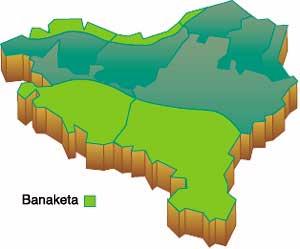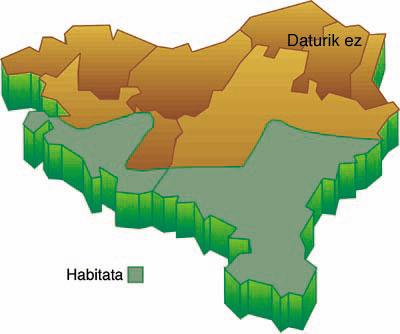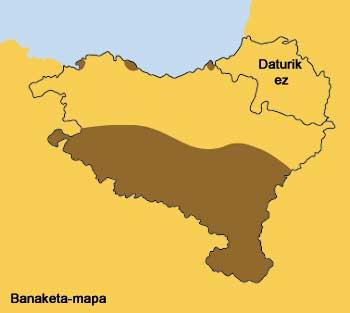Bardenas, more than desert
1992/12/01 Larrañaga, Jon Iturria: Elhuyar aldizkaria
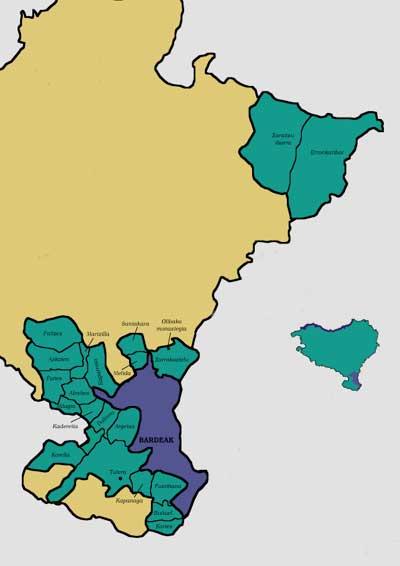
The Bardenas are an extensive area of 42,500 hectares of irregular shape located to the southeast of Navarre. They do not house populated villages or are attached to any municipality, being the exploitation in the hands of the peoples and municipalities that make up the Bardenas Reales Association for the rights acquired throughout history. This association consists of the neighbors of Villafranca, Argetas, Peralta, Balterra, Buñuel, Kapanaga, Kadereita, Kaparroso, Carcastillo, Corella, Kortes, Falces, Funes, Fustiñana, Marcilla, Melida, Milagro, Roncesvalles and Pasajes de Tudela and El.
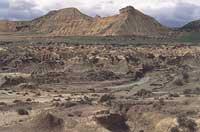
The main type of exploitation of the bardenas has been livestock, and especially grazing for many centuries, but the number of sheep that spend autumn and winter has been decreasing over the years, especially in the XX. throughout the 20th century. It should be noted, for example, that in 1600 more than 300,000 sheep or 163,400 heads were counted in 1854, while in 1983 only some 78,000 heads were counted, similar figures in recent years.
On the contrary, agriculture has grown in the 19th century. Since the 19th century, almost half of the surface of the Bardenas (about 21,000 ha) is currently being worked. Most of them, 20,000 ha, correspond to eyebrow land used in the production of wheat and barley, with a special agricultural exploitation regime, in which the land cultivated for a year must be left uncultivated the following year.
When talking about exploitation we cannot forget the shooting range of 2,000 ha leased by the Minister of Defense from 1951 to 2001. This area is used by Spanish and US planes and currently has a barracks.
As for the climate, we can consider that the climate of the Bardenas is continental Mediterranean. Rainfall is scarce (with an average collection of 400-450 mm/year) and there is great inter-annual variability. It also rains in a few days (the annual average is 60 days), when it rains intensely. The wind, especially that of Zierbana (northeast wind), is very frequent and therefore due to the high summer temperatures evapotranspiration is very high. Consequently, summer is warm and dry, with a significant water deficit. In contrast, winter is usually dry but quite cold, and frost is quite common.
Geological origin and geomorphology
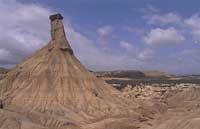
The Bardenas are located north of the geological unit called Depression of the Ebro. This depression arises in the alpine orogeny of the Tertiary, when the block of the Ebro sank after the rise of the Pyrenees and the Iberian Cordillera. The Bardenas consist of materials (clays, plaster, sandstone, limestone and conglomerates) that were eroded and transported from the end of the Eocene (38 million years ago) until the beginning of the Quaternary. These materials were deposited in the rivers and lakes that formed the Ebro basin, forming semi-horizontal sedimentary layers. However, in some cases, these layers have remained under the river terraces and glazis (river terraces) that the Ebro River and its tributaries have formed along the Quaternary.
When talking about the geomorphology of the bardenas, it is essential to mention the importance of the rainfall regime, since the high intensity of the rains has had a great importance in the formation of the gullies, ravines, chimneys of witches and hills witnesses that characterize the area. The first are narrow ravines generated by the erosion of soft materials (silts and clays) by the waters fallen by rain. Its shores are steep and constantly evolving and growing. The chimneys of witches and hills, on the other hand, are the mud hills that have remained uneroded due to the protection of layers of materials of great hardness (sandstones or limestones). They usually have a board shape and are often very steep.
Taking into account local heterogeneity, three clear landscape units are distinguished in the Bardenas. The north, called El Plano, is the river terrace of the hanging river Aragoa or glazisa, currently located 130 m above it. It has a horizontal plateau shape and has not suffered appreciable erosion. To the south of this, separated by several slopes and cliffs, is the Bardena Blanca. This second is a great erosive depression full of gullies, ravines, witch chimneys and numerous witness hills, and due to its peculiar reliefs and structures, it is probably the best known place of all the bardenas, whose name derives from the color of salt that emerges as a result of summer evaporation. Finally, to the south of the Bardena Blanca is the Bardena Negra, formed by a structural platform and testimonies of hills.
Vegetation
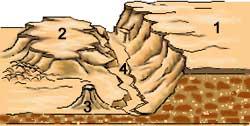
The primitive vegetation of the bardenas was probably a carrascal, which was cultivated in the Plano and in the Bardenas Negras, but growing on land suitable for agriculture, today it has disappeared almost completely, leaving in some places a rare holm oak (Quercus rotundifolia), witness of the ancient forest. However, due to the hardness of climatic or edaphic factors, in some places it is not possible to grow rodents, as they grow pine forests, espadrilles or other communities that can withstand much more severe conditions.
Due to the strong erosion they suffer, the main community is the pine forest in steep areas that are not able to maintain the carrascales. Today the pine forest grows mainly in the Bardenas Negras and in the Nature Reserve of Eguaras, and due to the almost total disappearance of the carrascales, it is the only type of forest of the Bardenas.
Its main species is the Aleppo pine ( Pinus halepensis). This pine is very common in arid areas of the Mediterranean region and is able to grow in any type of soil, except in saline soils. It supports very well the droughts and heat of the Bardenas, but is very sensitive to frost, so it only grows in relatively temperate areas.
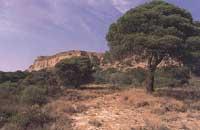
Due to its growth in areas with relatively severe edaphic conditions, this forest does not constitute a very continuous tree layer, so it presents numerous clearings. In these clearings grow a shrubby layer formed by several bushes and bushes very common in the Mediterranean scrub, being its main species the cattle ( Quercus coccifera), the common ( Rhamnus lycioides), the southern juniper ( Juniperus oxycedrus), the Phoenician sabine ( Juniperus phoenicea) and the marine Lentiscus ( Lis (
These plants, like many other plants that grow in the Mediterranean Region, have a series of very appropriate adaptations to live in arid areas, such as thick cuticle leaves that prevent water loss (sclerophilia), the existence of very small leaves or their total disappearance, the abundance of hairs that reflect light in leaves and other parts, etc.
The herbaceous layer consists of grasses and other herbaceous plants, the most common being the lively grasses Brachypodium retusum and Koeleria vallesiana.
In some cases, however, pine does not grow or are very few. In these cases the dominant community is the espadrille. This community is a fairly dense and high scrub, in which in addition to the abaritz, gravel, sabina, etc. that we have just mentioned, we find a leafy gartxo ( Phillyrea angustifolia), a carrasquillo ( Rhamnus alaternus), a scrub ( Genista scorpius), as well as the presence of herbaceous strata and bushes.
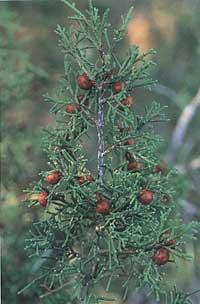
When the espadrille has degraded (for example, by fire or grazing), or when the soil is very rocky, another scrub formed by romeros and linens (Linum suffruticossum) grows. It is lower and more open than the espadrille and appears in several places of the Bardenas Blanca and Negra, being the most common plant community of today. In addition to the two species mentioned, the hawthorn flock, the thyme ( Thymus vulgaris), the maple (Lavandula latifolia), the jara ( Cistus clusii), the friar head ( Globularia alypum), the alevelar ( Dactylis glomerata subsp. hispanica), ruda ("Ruta angustifolia"), etc. we can find them.
As mentioned above, in addition to these three communities, we find others that grow in much more demanding ecological conditions and therefore are formed by plants of very high specialization.
In places where there is a periodic accumulation of materials transported by the fallen waters during storms, pastures formed by large live grasses grow, whose main species is the apricot ( Lygeum spartum). Also, due to the accumulation of feces and/or intense evaporation, in areas with a high concentration of nitrates, such as grazing grounds of sheep such as Salsola vermiculata and Artemisia, where the herba-alba matas predominate, a low scrub occurs, while in areas where evaporation caused by summer heat usually outcrops salt, we find communities of ornamental species.
The three communities mentioned do not fully cover the soil, and when the climatic conditions are adequate, that is, when it rains enough, they are filled with abundant terophyte vegetation (that is, opportunistic plants with a short life cycle that can take advantage of the right conditions).
As for the humid places, in the gullies and ravines that collect the waters of the storms, the dominant species is the tamariza ( Tamarix canariensis), which in some cases forms bushes that help protect the soil from erosion. In the vicinity of reservoirs and drinking water storage wells for sheep, reeds ( Juncus sp. ), common reed ( Phragmites australis) and leafy reed ( Typha angustifolia) are the most outstanding species.
Wildlife
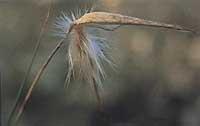
The fauna of the bardenas, in addition to their diversity, is composed of numerous species of great importance, some of them in the Basque Country and also in the Peninsula, very few.
We can only find amphibians in ponds and reservoirs scattered around the Bardenas. The most abundant is the common frog ( Frog perezi), accompanied by a spur toad ( Pelobates cultripes), a mottled toad ( Pelodytes punctatus), a common toad ( Bufo bufo) and a painted toad ( Discoglossus pictus). Among those praised are marmolaire triton ( Triturus marmoratus) and palate triton ( T. helveticus).
As for reptiles, although they do not appear in large densities, their number of species is relatively high. In the lizards we find the lizard ( Psammodromus algirus) and the Iberian lizard ( Podarcis hispanica), and in the snakes the snake of Montpellier ( Malpolon monspessulanus), the ladder snake ( Elaphe scalaris and the Peruvian snake ( Natru, etc). In addition, the gardatxo ( Lacerta lepida) and the trident ski ( Chalcides chalcides) stand out.
Some of the most outstanding birds of the bardenas are several species adapted to steppe environments. The main peculiarity of this medium is the lack of protection of large plants, so native species have developed a series of adaptations that are useful to address this situation. Therefore, for predators to not see them, they usually have cryptic brown plumage that serve to camouflage on the ground and, in addition, they run away letting fly when there is no other alternative. It is normal for some species to lay many eggs (to compensate for losses due to predators) and for many chickens to be nifuges, that is, to be able to escape and hide from the nest shortly after birth.
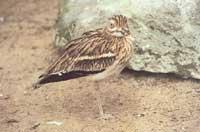
Among the species of this type are the ribbed vault (“Pterocles alchata”), the ribbed vault (“Pterocles orientalis”), the “zaguán” (“Burhinus oecdiemus”), the only large saddles that remain in Navarre (“Otis tarda”), the family bosquito (“Tetrotis tetrax”), the “pélvaquino (“Pélvico”), etc.
However, they are not the only birds of interest of the Bardenas, since in other habitats we can find species of great value. They include, for example, the lepagano piece of pinewood ( Caprimulgus ruficollis) and the moñudo cuckoo ( Clamator glandarius), the rocky pigeon that nests in the cliffs ( Columba livia) and the black cimarron ( Oenanthe leucura) or some predators such as the royal eagle ( Hieraërfalo the thalamus). Also note the saizuria ( Neophrom percnopterus), the griffon vulture ( Gyps fulvus) between the butchers and the royal owl ( Bubo bubo), the white owl ( Tyto alba) and the common mozolo ( Athene noctua) among the nocturnal predators.
In the case of bardene mammals, the same applies to all groups of animals. That is, although the number of species is relatively high, these species do not form large populations.
Among the species of this group are several micromammals, the most common being the field mouse ( Mus spretus), the field liron ( Elyomis quercinus) and the common satitsu ( Crocidura russula). Next to them are the hedgehog ( Erinaceus europaeus), the fairly abundant rabbit ( Oryctolagus cunniculus), the wild boar ( Sus scrofa) and several carnivores. The most abundant is the fox (“Vulpes vulpes vulpes”), accompanied by a wild cat (“Felis sylvestris”), a hare (“Mustela nivalis”), a turón (“Mustela putorius”), a garduña (“Martes foina”) and a badger (“Meles meles”).
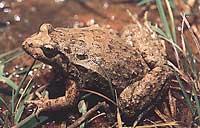
As we have seen, even though the human influence that the Bardenas have suffered has been evident, they still retain quite well.
Although the human influence suffered by the bardenas has been very evident, their state of conservation is quite good in general, and there are still places of great value. However, the change in traditional forms of exploitation, coupled with the notable increase in the number of visitors, increases the risk of degradation in this region. Therefore, protection of the Bardenas has been requested on several occasions, but so far only specific areas have been protected.
In any case, regardless of the measures taken to protect this region, we cannot forget that the protection of any place is also in the hands of all those who visit us.

Gai honi buruzko eduki gehiago
Elhuyarrek garatutako teknologia



